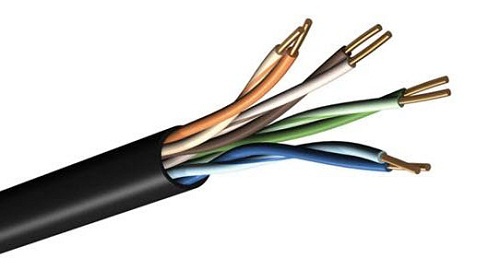Industrial Ethernet Cable: Should It Be Copper or Fiber?
The fact that the majority of industrial network failures occur due to signal transmission issues is a very good reason to be more knowledgeable about cabling solutions. Downtime costs for mission critical networks can range from $25,000/hour for an oil pipeline to $45,000/hour for a power plant.
If damaged or unsuitable cable is at the root of an outage, its duration can be lengthy because it is difficult to troubleshoot cable issues. With cable, there is a real incentive to install the right product for the job the first time. With this in mind, let's consider industrial Ethernet cabling options.


Four pair copper cable is shown on top and fiber cable is shown on the bottom. Signals are transmitted via copper when using copper cable and by light when using fiber cable.
Two Major Differences: Cable Length and Data Rates
Two of the key criteria that differentiate the use of copper or fiber optic cable are the length of the network cabling segments and the rate of data transmission.
1. Maximum Cable Length:
- Copper - 100 meters
- Multi mode Fiber - 2000 meters
- Single mode Fiber - 2000 meters
2. Data Rates:
- Copper Cat 5e - 100mb/s
- Copper Cat 6 - 1 Gb/s
- Fiber - 10 Gb/s
If the cable run lengths are long and the data volume is high, then fiber cable may be the obvious choice, and you can move on to selecting a specific fiber cable. Alternatively, if the runs are short and the data volume fits within copper's capacity (though don't forget to plan ahead by allowing for higher data requirements in the future), then copper it is and again you can move onto choosing the right copper cable for the application.
If the requirements are somewhere in the middle, you may want to consider additional general differences between copper and fiber Ethernet cable.
Five Differences Between Copper and Fiber Industrial Ethernet Cable
Here are some general differences that distinguish copper and fiber cable:
1. Electrical Noise:
- Copper cable - Susceptible unless Bonded-Pair and/or shielded
- Fiber cable - Immune
2. Spark Hazard:
- Copper cable - Hazardous
- Fiber cable - No spark hazard
3. Weight:
- Copper cable - Heavier
- Fiber cable - Lightweight
4. Durability:
- Copper cable - Lower, but can be improved with the right jacketing
- Fiber cable - High
5. Cost:
- Copper cable - Lower
- Fiber cable - Higher
Thus if you need lightweight cable that is immune to electrical noise and is not a spark hazard then fiber cable is most likely the right fit and you can move onto selecting a specific fiber cable.
Whether you are clear already if copper or fiber is right for the project, or you suspect that copper might do the trick with the right protection, your final choice should consider the external environment and the stresses the cable will face. Remember the high cost of failure when mission critical networks go down and cable is the root cause? Your project will be well served by digging a little deeper into the specific application requirements.
Selecting the Right Cable Jacket
Here are some of the topics to consider about a particular application before selecting a cable jacket:
- Operating temperature range
- Chemicals, dust, or water present
- Wash down environment
- Amount of electrical noise
- Vibrations
- Exposure to being cut, crushed or abraded
- Flexing or constant motion of cable
It is because of these environmental and usage conditions that commercial (office) Ethernet cable or any other non-industrial cable is unsuitable.
The cable jacket can adapt a cable for particular environmental conditions, as shown in the following table:
| Copper Cable | |
|---|---|
| Fiber-Optic Cable | |
| Issue | Jacket to Specify |
| General Purpose for Most Applications | PVC (Polyvinyl Chloride) |
| Sunlight/UV Resistance |
Any |
| Oil Resistance | Most |
| Chemical and Fuel Resistance | FEP (Trade name: Teflon) |
| Temperatures to 150 degrees C | FEP (Trade name: Teflon) |
| Plenum Rating* | FEP (Trade name: Teflon) |
| Low Smoke Generation, No Toxins When Burned | LSZH (Low Smoke Zero Halogen) |
| High Mechanical Stress (Abrasion, Cut Through) | Polyurethane |
| Halogen Free | LSZH (Low Smoke Zero Halogen |
| Continuous Flex | TPE (a type of plastic) |
| Weldsplatter Resistance | TPE (a type of plastic) |
| Direct Burial | Polyethylene |
| Maximum Mechanical Protection | Armoring |
| Fiber-Optic Cable | |
| Issue | Jacket to Specify |
| General Purpose for Most Applications | PVC |
| Additional Chemical and Abrasive Resistance | CPE |
Know Your Application, Then Select Your Cable
Just as knowing your application is vital to selecting the right switches, routers and firewalls for an industrial Ethernet network, it is also vital in selecting the right cable. When it comes to industrial Ethernet cable, long runs and high data volumes call for fiber cable. For short runs and average data requirements, copper cable will do the job. Next consider the operating environment and mechanical stresses the cable will face to help you zero in on a final choice.
* A plenum is a space use for air circulation for heating and ventilation systems. Cable may be located in a plenum and if there is a fire, the cable will burn and spark. To avoid this, plenum cable is coated with a fire retardant that does not give off toxic gases and smoke as it burns.
